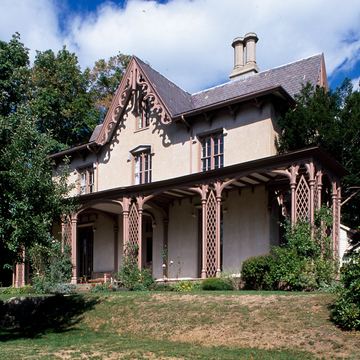The only example in the Boston Metropolitan area of a building by New York architect Alexander Jackson Davis, the John B. Angier House typifies his Gothic Revival style. Landscape designer Andrew Jackson Downing and others popularized rural and suburban cottages in this style in books in the 1840s and 1850s. Davis and Downing collaborated on this project. Unfortunately, nothing survives of Downing's landscape design, except perhaps the elevated terrace siting of the house with a low stone wall along the sidewalk. The Angier House resembles other Davis houses having a center gable with vergeboard, a long verandah with a Gothic trellis design, and decorative chimney pots. Original drawings for the Angier House document his scheme for a low Gothic-style balcony on the roof of the porch over the main entrance. The stucco exterior was probably once scored to suggest ashlar masonry.
John Angier, who was the headmaster for a local girls school, had married Abby Adams, granddaughter of President John Adams and niece to President John Quincy Adams. He later gave up the school to work in the Boston office of a western railroad company. The Angiers also had furniture made by Davis's cabinetmaker, Richard Byrnes.







